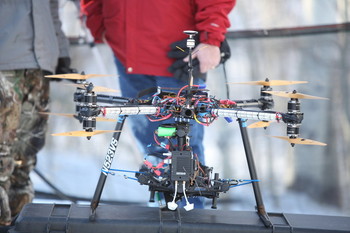ESPN Deploys Drone to Cover Winter X-Games
ASPEN, COLO.—Extreme sports fans will get a new perspective on their favorite Winter X-Games events with ESPN’s announcement that the sports network will use a drone to capture all the action at a selected venue.
Extreme sports and drones are a natural match, but gaining approval to use the drones was a new experience for the sports network, according to Chris Calcinari, vice president, ESPN & ABC Sports remote production operations. “The whole process is so new, it almost too us up the last minute to get all the approvals signed off,” he said. The games run from Thursday, Jan. 22-25 in Aspen Colo.

ESPN is testing a drone to cover the Winter X-Games in Aspen, Colo, Jan. 22-25. (Photo by Gabriel Christus/ESPN Images)
The process began last fall when the Federal Aviation Administration—which is currently developing rules for the use of drones, but severely restricts use to certain commercial and government applications—approved six drone companies to provide commercial services for motion picture and television companies.
“Once we knew we had the right to do this, we started working with the vendors,” Calcineri said.
After much due diligence, ESPN settled on Vortex Aerial in Los Angeles. Calcineri says the company came well prepared for handling such a project. “The vetting process on the vendor side was very rigorous,” he said. “These people literally have to be pilots and medically certified to be approved.”
The first part of the process involved applying for a certificate of authorization from the FAA, which is only for what is described as “closed set environments,” according to Calcineri. “The only people who can be in the ‘fly zone’ are people who are part of the production.” Calcineri adds that this restriction will make it difficult for ESPN and other networks to use drones in more traditional venues. “When you think about all the ‘stick and ball’ sports ESPN covers—including Major League Baseball and the NFL— I think it will be a very big challenge, at least under the current FAA standards.”
Get the TV Tech Newsletter
The professional video industry's #1 source for news, trends and product and tech information. Sign up below.
The drone, which measures approximately 40 inches in diameter and weighs 25 pounds, will be used to cover the “X Course,” a closed course that fits within the FAA regulations. Two events, “Snowboarder X,” (11 AM to 1:30 P.M., Thursday, Jan. 22, and 10 a.m. to 1:30 p.m. Friday on ESPN) and Snowmobile coverage on Saturday, Jan. 24. will be covered by the drone.
Vortex Aerial will use the Paralinx receiver/transmit system coupled with a Panasonic GH-4 mirrorless DSLR camera to shoot and transmit the footage in 1080p/60, according to Calcineri. The drone is restricted to 400 feet above ground level. “We’ll never operate that high,” Calcineri added.
The drone team includes three staff members: a pilot, camera operator and spotter, who keeps an eye on where the drones go. The pilot in this event is Chris Schuster, owner of Vortex Aerial. “He’s been flying and utilizing hobby type aircraft for more than 40 years,” Calcineri said.
The events will cover the athletes from the top to the bottom of the X Course, according to Calcineri. “There will be three particular framing sequences. We’re looking at following behind them, following next to them—as if you’re one of the skiers—and following in front of them so the audience is seeing them coming towards them.”
All of the athletes competing in the X Course events have been briefed on the use of the drone. There was no hesitation on the part of the athletes. “These athletes are very progressive and wear GoPro cameras,” he said. “They’re very excited about it.”
ESPN’s annual X-Games—both winter and summer—have long been an incubator for new television technology and the use of drones marks the first time the aerial devices are being used to cover a live sporting event in the United States, according to Calcineri. “I can’t think of any other time where we’ve had an untethered camera,” he said. “Even if you think about skycam, flycam and some of the cablecam systems we’ve used, they’re even connected to something. This is the first time that this device is going to be able to fly pretty much free and the limit is really up to the director’s imagination. So I think there’s going to be some very compelling shots that our viewers have never seen before.”
Tom has covered the broadcast technology market for the past 25 years, including three years handling member communications for the National Association of Broadcasters followed by a year as editor of Video Technology News and DTV Business executive newsletters for Phillips Publishing. In 1999 he launched digitalbroadcasting.com for internet B2B portal Verticalnet. He is also a charter member of the CTA's Academy of Digital TV Pioneers. Since 2001, he has been editor-in-chief of TV Tech (www.tvtech.com), the leading source of news and information on broadcast and related media technology and is a frequent contributor and moderator to the brand’s Tech Leadership events.

